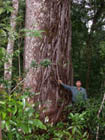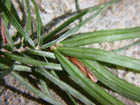Conservation Status

Pinus krempfii
Lecomte 1921
Common names
Thông lá det, Ngo rí (Vietnamese) (FIPI 1996).
Taxonomic notes
Syn: Ducampopinus krempfii (Lecomte) A.Chev. On purely morphological grounds, this is probably the most unusual species in the genus due to its flattened, ribbed, blade-like needles. The needles have a singular vascular bundle, thus the species is commonly assigned to Subgen. Strobus (Price et al. 1998), but Little and Critchfield (1969) assigned it to a distinct subgenus, Ducampopinus (A. Cheval.) de Ferré. The composition of heartwood phenolics is very typical of haploxyon pines (Price et al. 1998). Wang et al. (1999, 2000) used chloroplast DNA analysis to compare P. krempfii to a variety of other species in subgenera Pinus and Strobus as well as 8 outgroup taxa; they found that of the two subgenera, P. krempfii clearly falls into subgenus Strobus, probably in a monotypic subsection within section Parrya.
The taxon Pinus krempfii var. poilanei Lecomte (1924) was described on the basis of its needles being longer, 6-7 cm, and much broader, 4-5 mm, than the material Lecomte had first described (Lecomte 1921). Increased knowledge of the growth pattern of the species (Ferré 1948, Buchholz 1951, Rushforth [no date]) shows it to be the normal immature (not juvenile) foliage of the species, retained until the tree is at least to 12 m tall and 25 cm in diameter, while growing in shade.
Description
Tree to 35-55 m tall and 200 cm dbh (FIPI 1996, Newman [no date], zur Mühlen [no date]), with a monopodial bole, often buttressed (FIPI 1996), and a broad domed crown with many large branches (FIPI 1996, Newman [no date], Rushforth [no date]).
Bark is silvery grey, scaly-flaky (LeComte 1924), peeling off into irregular fragments, having resin ducts (FIPI 1996), similar to the species of section Gerardiana (Newman [no date]).
Needles are lanceolate-falcate, 3-6 cm long, 2-4 mm wide on adult trees, much larger on juvenile trees. The fascicle sheath is composed of few broad acute scales in an alternate arrangement (LeComte 1924), with each scale markedly longer than the previous, the longest to 15 mm, to 40% of the full length of the fascicles examined (Newman [no date], Rushforth [no date]). The sheath is early deciduous; similar to that of P. bungeana, though in that species the scales are arranged in a loose spiral. Foliage is flattened on weak shoots (Newman [no date]), with fascicles flattened and held flat in a single plane, unique in Pinus. On stronger shoots foliage is all around the shoot (Vidakovic 1991, van Dung [no date]). The shoots are glabrous, with small (1 mm) decurrent scale-leaf bases deciduous by the second to fourth year. This gives the leafless shoot a strong similarity to some piñons, and most notably to P. pinceana, and later, after the scale leaf bases are shed, to P. bungeana. Shoots low on old trees (Newman [no date]) and young trees in shade (zur Mühlen [no date]) are very slender and slow-growing (1-4 cm long, 1.3 mm thick), with 2-10 scattered fascicles on each year's growth, here again resembling P. pinceana; stronger, coning shoots are more typical for a pine, 5-10 cm long and 3-5 mm thick with numerous fascicles (van Dung [no date]).
Male cones are sometimes carried on small weak, ± pendulous, tassel-like shoots with few to no needle fascicles (Newman [no date]), a feature shared with P. pinceana. Immature pollen lacks the air bladders seen on pollen of all other pines, though this may be due to the immaturity of the pollen, dissected out of c. 2-3 months premature male cones (Page [no date]). Mature pollen still undescribed.
Mature seed cones 3.5-6 cm long (ovate, 4-9 cm in (FIPI 1996), glossy orange-brown when freshly mature (van Dung [no date]). Fertile scales 12-20 with a well-defined dorsal umbo and no sealing band. The apophysis has a raised transverse ridge to 3-4 mm thick, the umbo small and unarmed, with a minute (less than 0.5 mm) mucro. Scales are similar to those of P. rzedowskii. Cone peduncle 7-15 mm long, 4-5 mm thick, curved so that cone is pendulous; similar to that of P. squamata. Cones produced cones in April-May; seeds mature in July-September (FIPI 1996).
The seed (infertile seed in van Dung [no date], and cone scale seed cavities of Rushforth [no date] and zur Mühlen [no date]) are 4-5 mm long with a 10-15 mm articulate wing, similar to seed of P. balfouriana and P. longaeva. Seedlings are typical of many other pines, with glaucous single needles; as in other species in this subgenus and in sect. Pinea of subgenus Pinus, they are produced for several years before mature foliage appears (Rushforth [no date]).
Buchholz (1951) and Little and Critchfield (1969) reported the absence of ray tracheids, but Greguss (1962) and Van der Burgh (1973) found them to be present, as in all other pines. Erdtman et al. (1966) analysed wood chemistry and found heartwood polyphenols similar to other haploxyl pines in both subsect. Strobi and subsect. Gerardianae.
Distribution and Ecology
Viet Nam: local in Khanh Hoa and Lam Dong, principally around Bi Doup mountain. The species is locally frequent, with 200 trees in one population (Newman [no date]). Grows emergent above the evergreen monsoon forest canopy on steep slopes at elevations of 1500-2000 m, often in mixed stands with Chamaecyparis hodginsii, Pinus dalatensis, Dacrydium elatum and other broad-leaved trees such as Symingtonia populnea and Rhodoleia championii. Pinus kesiya forest grows at relatively higher and tropical rainforest at lower elevations (Rushforth [no date], FIPI 1996). It often grows in sites having black-grey, deep humus soils or humus-rich loamy soils along streams (FIPI 1996). Reportedly, natural regeneration on the site is very low (Jerry W. Leverenz e-mail 1998.10.13). Regeneration can occur in deep shade on deep, humus-rich soil (Newman [no date]) but is better in more open situations (Ruchforth [no date]).
Zone 10 (cold hardiness limit between -1°C and +4.4°C) (Bannister and Neuner 2001).
Remarkable Specimens
Ethnobotany
Wood soft, light and slightly resinous, having good physical and mechanical properties (FIPI 1996).
Observations
Can only be seen in the wild within its exceedingly limited range. I have a report that the Vietnamese a" are very proud of the few trees that are left" and it is difficult to secure permission to visit the site (Jerry W. Leverenz e-mail 1998.10.13). I have found it in only one botanical garden, Kew.
Remarks
P. krempfii can best be regarded as a primitive but otherwise fairly typical pine with a number of special adaptations to moist subtropical climate and dense forest not found elsewhere in the genus, other pines being of recent immigration to subtropical areas (Mirov 1967) and confined to drier substrates.
Listed as threatened in Viet Nam by the World Conservation Monitoring Center. This species has attracted the interests of many Vietnamese and foreign scientists.
Citations
Buchholz, J T. 1951. A flat-leaved pine from Annam, Indo-China. American Journal of Botany 38: 245-252.
Burgh, J van der. 1973. Holzer der Niederrheinischen Braunkohlenformation 2. Rev. Palaeobot. Palynol. 15: 73-275.
Erdtman, H., B. Kimland and T. Norin. 1966. Wood constituents of Ducampopinus krempfii (Lecomte) Chevalier (Pinus krempfii Lecomte). Phytochemistry 5: 927-931.
Ferré, Y de. 1948. Quelques particularités anatomiques d'un pin indochinois P. krempfii. Trav. Lab. Forest. Toulouse T.1 vol.4 art.25: 1-6.
Greguss, P. 1962. Le genre Ducampopinus est-il valable en vertu de sa xylotomie? Trav. Lab. Forest. Toulouse T.1 vol.6 art.13: 1-6.
Lecomte, H. 1921. Un pin remarquable de l'Annam, Pinus krempfii. Bull. Mus. Hist. Nat. Paris 27: 191-192.
Lecomte, H. 1924. Additions au sujet de Pinus krempfii H Lec. Bull. Mus. Hist. Nat. Paris 30: 321-325.
Newman, M. [no date]. Field notes and herbarium specimens at Edinburgh RBG.
Page, C.N. [no date]. Pers. comm. to M P Frankis, based on study of M. Newman material.
Rushforth, K. [no date]. Field notes and herbarium specimens at Edinburgh RBG.
van Dung, Vu. [no date]. Herbarium specimens at Oxford Forestry Institute.
zur Mühlen, K.-H. [no date]. Herbarium material at Potsdam.
See also
The species account at Threatened Conifers of the World.
Bond, R. 2002. Pinus krempfii: A rare pine from Vietnam. American Conifer Society Quarterly 19:10-13.
Hiep et al. 2004.
Ickert-Bond, Stefanie M. 1997. Pinus krempfii Lec.- a Vietnamese conifer with problematic affinities. American Journal of Botany 84: 203 (Abstr.).
Ickert-Bond, Stefanie M. 1997. Pinus krempfii Biosystematics of Pinus krempfii Lecomte. M.S. Thesis, Arizona State University, Tempe.
Ickert-Bond, Stefanie M. 1999. Morphology and microgametogenesis in Arizona native Joint-fir, Ephedra (Ephedraceae). Journal Arizona-Nevada Academy of Science 34 (Proc. Suppl.): 10 (Abstr.).
Ickert-Bond, Stefanie M. 2000. Cuticular micromorphology of Pinus krempfii Lec. (Pinaceae) and additional species from southeast Asia. International Journal of Plant Sciences 161(2):301–317.
Ickert-Bond, Stefanie M. 2001. Reexamination of wood anatomical features in Pinus krempfii (Pinaceae). International Association of Wood Anatomists Journal 22(4):355–365.
Luu and Thomas 2004 provide a description, range map, conservation status, drawings and photos, and a wealth of additional information.
Much of the text for this page was prepared by Michael P. Frankis.




